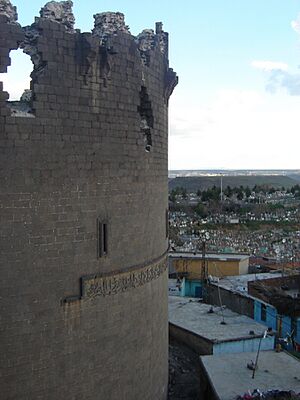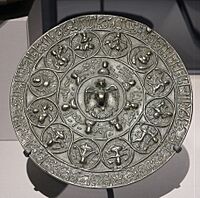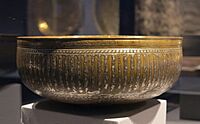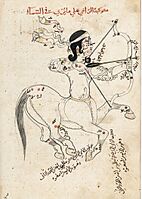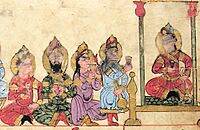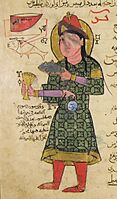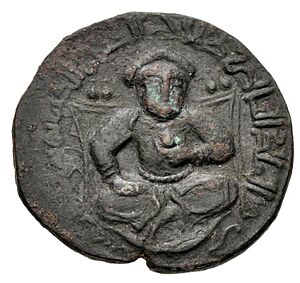Artuqids facts for kids
Quick facts for kids
Artuqid State
Artuklu Beyliği
|
|||||||||||
|---|---|---|---|---|---|---|---|---|---|---|---|
| 1102–1409 | |||||||||||
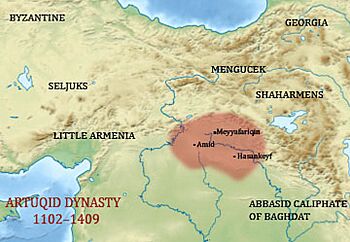 |
|||||||||||
| Capital | Hasankeyf, Diyarbakır, Harput, Mardin, in chronological order | ||||||||||
| Common languages | Turkish, Arabic, Syriac | ||||||||||
| Religion | Sunni Islam | ||||||||||
| Government | Beylik | ||||||||||
| Bey | |||||||||||
| History | |||||||||||
|
• Establishment
|
1102 | ||||||||||
|
• Takeover by Zengid Dynasty (Aleppo)
|
1127 | ||||||||||
|
• Vassal of the Ayyubid Sultanate (Hasenkeyf)
|
1232 | ||||||||||
|
• Takeover by Sultanate of Rum (Harput)
|
1234 | ||||||||||
|
• Annexation by Kara Koyunlu (Mardin)
|
1409 | ||||||||||
| Currency | dinar | ||||||||||
|
|||||||||||
| Today part of | Syria Turkey |
||||||||||
The Artuqid dynasty was a powerful family that ruled parts of eastern Anatolia, northern Syria, and northern Iraq. They were a Turkoman group from the Oghuz Döğer tribe. The Artuqids followed the Sunni Muslim faith.
This dynasty started in 1102 as a small state called an Anatolian Beylik. It was part of the larger Seljuk Empire. The Artuqids were named after their founder, Artuk Bey. His sons and later family members ruled in three main areas:
- The Hasankeyf branch ruled near Hasankeyf from 1102 to 1231.
- The Mardin branch ruled from Mardin and Mayyafariqin from 1106 to 1409. They also controlled Aleppo for a short time.
- The Harput branch started in 1112 and was independent from 1185 to 1233.
Contents
A Look at Artuqid History
The Artuqid family was founded by a general named Artuk Bey. He first served under Malik Shah I and then under Tutush I, a Seljuk ruler in Damascus. In 1086, Tutush made Artuk the governor of Jerusalem.
Artuk Bey passed away in 1091. His sons, Sökmen and Ilghazi, took over. However, they were forced out of Jerusalem in 1098 by the Fatimid ruler. The very next year, the Crusaders captured Jerusalem after a long siege.
Sökmen and Ilghazi then settled in Diyarbakır, Mardin, and Hasankeyf. These cities were in a region called al-Jazira. Here, they often fought with the Seljuk sultanate.
Important Battles and Changes
In 1104, Sökmen, who was the bey (ruler) of Mardin, won a big victory against the Crusaders at the Battle of Harran. Later, Ilghazi took over from Sökmen in Mardin. In 1118, he gained control of Aleppo. The next year, Ilghazi defeated the Crusader state of Principality of Antioch at the Battle of Ager Sanguinis in 1119.
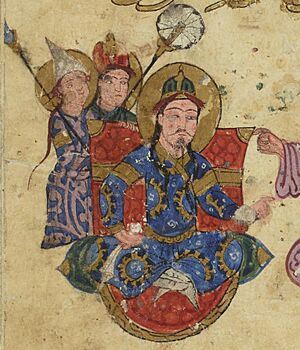
After attacking the County of Edessa, Ilghazi made peace with the Crusaders. In 1121, he marched north into Armenia and then Georgia. However, he was defeated by David IV of Georgia at the Battle of Didgori.
Ilghazi died in 1122. After his death, the Artuqid lands were divided among the family. The main branches were in Harput, Hasankeyf, and Mardin. Over time, the Artuqids became less powerful. They became vassals (meaning they had to obey and pay tribute) to stronger empires like the Zengids and later the Ayyubids.
For example, the Hasankeyf branch was destroyed by the Ayyubids in 1231. The Harput branch was taken over by the Sultanate of Rum in 1234. The Mardin branch lasted the longest. It survived as a vassal state under the Ayyubids, the Sultanate of Rûm, the Il-Khanate (Mongols), and the Timurids. Finally, in 1409, the Kara Koyunlu tribe captured Mardin, ending Artuqid rule completely.
Art and Buildings
Even though the Artuqids were often at war, they built many amazing structures. Their rulers ordered the construction of mosques, markets, bridges, hospitals, and public baths. These buildings helped the people living in their lands.
The Artuqids also left behind important cultural treasures. They supported writers and were skilled in metalworking. For example, the beautiful door and door handles from the Great Mosque of Cizre show their amazing metalwork. You can see these pieces in the Turkish and Islamic Arts Museum in Istanbul.
They made big improvements to the Diyarbakır City Walls. The Urfa Gate was rebuilt by Muhammad, a son of Kara Arslan. Two impressive towers, Ulu Beden and Yedi Kardeş, were built in 1208. The ruler Nāṣir al-Dīn Maḥmūd designed the Yedi Kardeş tower himself. It has the Artuqid symbol of a double-headed eagle on its walls.
The Artuqids also built a large caravanserai (a roadside inn for travelers) in Mardin. The Malabadi Bridge, an amazing feat of engineering, is still used regularly today. The Old Bridge, Hasankeyf, though partly ruined, was built by Kara Arslan in 1116.
Many large mosques, like those in Mardin and Silvan, were developed by Artuqid rulers. The congregational mosque of Dunaysir (now Kızıltepe) was started by Yülük Arslan and finished by his brother Artuk Arslan.
-
A decorative piece from the Turkish and Islamic Arts Museum in Istanbul.
Literature and Science
The Artuqids also supported the creation of books and scientific works in Arabic.
- In 1131, a copy of al-Sufi's astronomy book, The Book of Fixed Stars, was made in Artuqid Mardin. This book combined Greek and Arabic knowledge about stars.
- Kara Arslan (who ruled from 1148–1174 CE) ordered a new Arabic translation of a medical book called De Materia Medica.
The Artuqid ruler Nasr al-Din Mahmud (who ruled from 1201–1222) asked for a special edition of Al-Jāmi‘ fī ṣinā‘at al-ḥiyal. This book, by Ibn al-Razzaz al-Jazari, showed many clever mechanical devices. The pictures in the book give us a look into the Artuqid court at that time. Many figures in the book wear typical Turkic clothes, including a long coat, boots, and a special tall hat called a sharbush.
Another important book, Maqamat al-Hariri, is also believed to be from the same Artuqid art school.
Artuqid Rulers
The Artuqid dynasty had several main branches, each with its own rulers.
Hasankeyf Branch Rulers
This branch first ruled from Hasankeyf. Their capital later moved to Diyarbakır in 1183.
- Sökmen: 1102–1104
- Rukn al-Dawla Dāʾūd: 1109–1144
- Kara Arslan: 1144–1174
- Nūr al-Dīn Muḥammad: 1174–1185
- Nāṣir al-Dīn Maḥmūd: 1201–1222
- Rukn al-Dīn Mawdūd: 1222–1232/33
After Rukn al-Dīn Mawdūd, the Ayyubids took over the Hasankeyf Artuqid lands.
Harput Branch Rulers
The Harput branch became independent from the Hasankeyf branch in 1185.
- Imad ud-din Abu Bakr: 1185–1204
- Ibrahim ibn Abu Bakr: 1203–1223
- Ahmad Khidr: 1223–1234
- Artuq Shah: 1234
The Seljuk Sultanate of Rûm conquered Harput in 1234.
Mardin Branch Rulers
The Mardin branch ruled from Mardin and Mayyafariqin from 1101 to 1409.
- Ilghazi: 1107–1122
- Timurtash: 1122–1154
- Alpï I: 1154–1176
- Yülük Arslan: 1184–1203
- Artuk Arslan: 1203–1239
- Qara Arslan: 1260–1292 (He submitted to the Mongol leader Hulegu.)
- Al-Zahir Majd al-Din 'Isā: 1376–1407
- Al-Salih Şhihab al-Din Ahmad: 1407–1409
The Kara Koyunlu tribe conquered Mardin in 1409, ending the Artuqid rule there.
Aleppo Subbranch Rulers
This branch of the Artuqids ruled Aleppo for a short time.
- Ilghazi: 1117–1121
- Belek Ghazi: 1123–1124
- Timurtash: 1124–1125
In 1128, Zengi took over Aleppo.
Artuqid Coins
Artuqid coins were very special because they often showed figures and designs. These designs were inspired by old Greek and Roman art, as well as Byzantine styles.
See also
- List of Sunni Muslim dynasties
- Artuklu Palace


